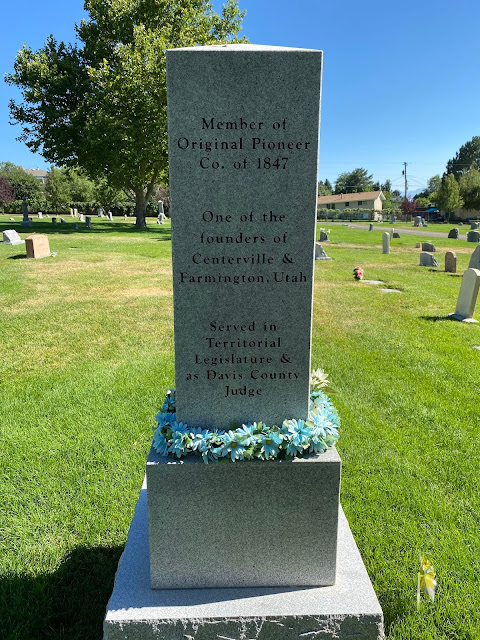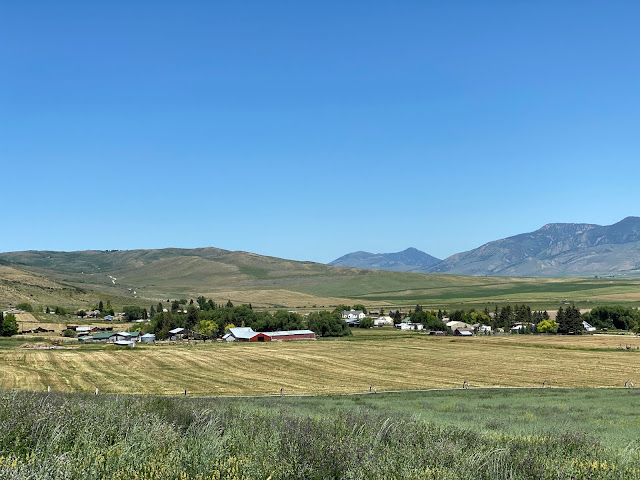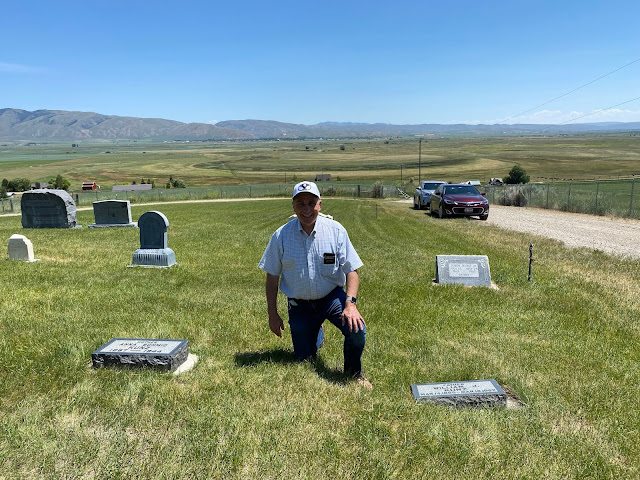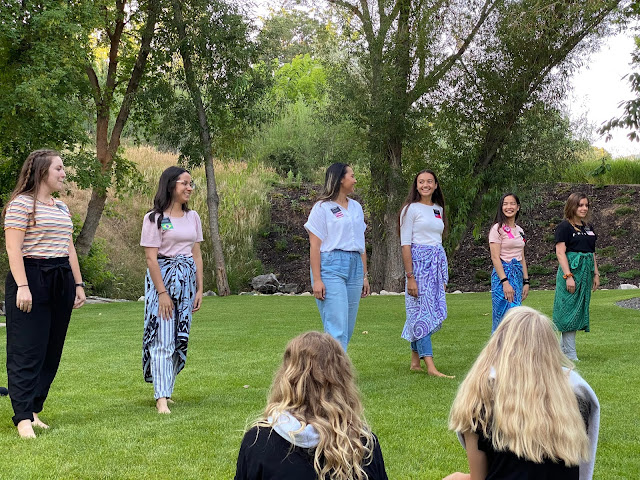Zone Meetings and Lunch
Monday and Tuesday, July 13-14, we had zone meetings. Two zones met in the morning and two in the afternoon for a total of eight zones over the two day. Sister Burkinshaw was responsible for lunch and decided that pizza would be a good choice. She organized the orders so that the various food allergies were addressed either with gluten-free pizza or with salads from the COB (Church Office Building) cafeteria. At the end of each of the four meetings, she and/or Elder Burkinshaw picked up 20 large pizzas (10 cheese and 10 pepperoni) plus the necessary gluten-free pizzas and salads. Each Sister got 3 slices to begin and at the end, there were additional slices for those who wanted them. It all worked out great.
Here are a few pictures of the zone meetings and lunch/dinner:
 |
| Zone meeting (two zones with about 45 Sisters, repeated 3 additional times) set up on the ground floor of the Relief Society Building where our office is located. |
 |
| A musical number presented a the zone meeting. |
 |
| The other set of Zone Leaders for this session serving pizza to their Sisters. |
 |
| A table of our Sisters eating in the main lunch area in the basement of the Joseph Smith Memorial Building. |
Temple Square Summer Flowers
The summer flowers are doing well here on Temple Square and here's a few examples.
 |
| The beautiful baskets hanging from the light poles between the Lion House and the Church Administration Building |
 |
| Another shot of the beautiful flowers in the hanging baskets. |
 |
| The summer flowers at the back of the Church Administration Building. |
 |
| The stunning flowers around the entrance to our office on Temple Square. |
 |
| Sister Burkinshaw's beauty matches the gorgeous flowers near the entrance to the Mission Office in the Relief Society Building. |
East Zone Activity at the Littlefield's
President and Sister Littlefield (First Counselor in the Mission Presidency and Companion) invited our Zone for a Friday night activity at their beautiful home in Kaysville. They served chips with salsa and guacamole and then a wonderful dish the Littlefields called Sara's Old Fashioned (taco seasoned meat with beans, peppers, cheese, guacamole, etc between two seasoned corn tortillas). The Sisters also put on a talent show. And at the end, we had two different birthday cakes for two Sisters who had birthdays. Here are some pictures:
 |
| All the Sisters loved the chips, guacamole and salsa! |
 |
| The way to a Sisters heart is through their stomachs also! ;-) |
 |
| The Littlefields have their own pickle ball court and we taught some of the Sisters how to play. |
 |
| Sister Steinmetz from Brazil and Sister King from Hawaii are our two Zone Leaders. |
 |
| For one of the talents, Sister Lopez used the arms of her companion, Sister Rivera, to go through her makeup and personal hygiene routine. It was hilarious! |
 |
| Here Sister Burr (Temecula, CA), Sister Webb (Gilbert, AZ), Sister Glenn (Molalla, OR) and Sister Sanders (Fishville, VA) sang "I Will Be What I Believe" accompanied by the ukelele. |
 |
| A group picture with President and Sister Larsen, President Littlefield, the Sisters in our zone and Elder and Sister Burkinshaw. |
 |
| Elder and Sister Burkinshaw enjoying birthday cake on the balcony of the Littlefield's home overlooking their beautiful back yard. |
Family History
Here are the fan charts with the ancestor sites we visited circled in yellow:
 |
| From Sister Burkinshaw's family we have sites from the Croft Line and the Tippets Line. |
Refer to these charts if you get lost in the family relationships.
Farmington Cemetery
Thomas Grover and Caroline Emma Whiting are Elder Burkinshaw's 4th great grandparents through the Beck Line. Thomas and Caroline joined the church in 1834 in Freedom, NY (65 miles SW of Palmyra). Caroline Whiting Grover died at the young age of 31 a week after bearing her seventh child and is buried in the old Nauvoo Burial Grounds and unfortunately most of those buried there have no grave marker. Her husband, Thomas Grover, lived a long life (with five additional wives and 52 children) and served in various callings in the Church including the Nauvoo High Council (see D&C 124:132). He came west in the original company of pioneers in 1847 but was left at the Platte River crossing to build barges to carry wagons across the Platte. He arrived in the valley in October 1847 with the Charles C Rich company. He founded and was the first mayor of Centerville and helped to found Farmington, where he is buried.
 |
| Grave marker for Elder Burkinshaw's 4th great grandfather, Thomas Grover in the Farmington Cemetery. |
 |
| The south side of Thomas Grover's memorial reads as follows: Thomas Grover, An enterprising, industrious & charitable pioneer. A devoted & faithful member of the Church of Jesus Christ of Latter-day Saints. Captain in the Nauvoo Legion & personal bodyguard of the Prophet Joseph Smith. Called on several missions and to serve on numerous High Councils of the church. |
 |
| The east side of Thomas Grover's memorial gives the names of his beloved wives. Elder Burkinshaw's family comes through his first wife, Caroline Whiting, who died in Nauvoo a week after giving birth to her seventh child and she is buried in the old Nauvoo Cemetery. |
 |
| The north side of Thomas Grover's memorial recognizes some of his accomplishments: Member of the Original Pioneer Co. of 1847 One of the founders of Centerville (first mayor) & Farmington, Utah Served in Territorial Legislature & as Davis County Judge |
 |
| Elder Burkinshaw with the grave marker of his 4th great grandfather, Thomas Grover. |
There are many stories about the life of Thomas Grover (see Family Search) but here is a short one that reveals his character.
In 1847-48 during the plague of crickets in the Salt Lake Valley, Thomas had plowed his land in the fall and during the warm spell in February he planted his wheat. It came on early and was ready for harvesting before the grasshoppers got so bad, while the late grain was nearly all eaten by them. That season he harvested seven hundred bushels of wheat which would have brought five dollars a bushel on the public market, but Brother Thomas loaned and sold every bushel of it, except enough for his own family for the tithing office price of two dollars a bushel. At this time Sister Brown, a widow sent her boy to ask Brother Grover to sell her a little flour, just a few pounds. Brother Grover sent his son to fill a grain sack full of flour and put it on the boy’s wagon. The frustrated youth asked how much a whole sack of flour would cost adding that he had only a little money. To which Brother Grover replied, “I do not sell flour to widows and fatherless children.” As the sack was placed upon the wagon the happy boy drove away in tears.
Southeast Idaho Family History
On Saturday, July 18, we drove up to southeast Idaho to continue our visits to our ancestors gravesites. We met Patti and Rayde there and we missed having Robyn go with us but her dog Keima was not doing well so she stayed home to care for her. It was a nice trip and the weather in Idaho was 15°F cooler than Salt Lake City.
Paris Cemetery
Our first stop was the Paris Cemetery where ancestors from both sides are buried.
 |
| The grave marker of Thomas Wooley Croft and Elizabeth Richardson Croft who were the parents of Edward Wooley Croft who is Sister Burkinshaw's great grandfather. Thomas and Elizabeth emigrated to Utah in 1869 and lived for a time in Tooele where he was Captain Croft, bandmaster for the Tooele brass band. In December 1880, the family moved to Paris, ID where Thomas again was bandmaster for the town of Paris. He died less than a year later. |
 |
| Aunt Patti and Uncle Rayde at the grave marker of Thomas Wooley Croft and Elizabeth Richardson Croft in the Paris Cemetery. |
 |
| The grave marker for John Passey and Ann New Passey (see the top angled portion of the marker) and their son Thomas Passey in the Paris Idaho Cemetery. |
 |
| Elder Burkinshaw behind the memorial for John Passey and Ann New Passey and their son Thomas Passey in the Paris Idaho Cemetery. |
 |
| Elder and Sister Burkinshaw showing that the members of their respective family trees are located adjacent to each other in the Paris Idaho Cemetery. A validation of what we already know that their match was made in heaven! ;-) |
 |
| The Paris Tabernacle was constructed of red sandstone that had to be transported by wagon or sled from a quarry 18 miles away. It still serves as the center of the Church in the Bear Lake area. |
Zwischenfluh Cemetery
While serving a full-time mission in the London Temple, we visited the ancestral home of the Kunz family in Switzerland and the cemetery where Johannes Kunz I, the patriarch of the Kunz family and the first to be baptized, was buried.
 |
| The Zwischenfluh cemetery where Johannes Kunz I was buried. Unfortunately the Swiss culture is to "repurpose" grave markers and cemetery plots so his headstone is gone. |
Ovid Cemetery
The Ovid Cemetery is the resting pace of John Kunz II, Elder Burkinshaw's third great grandfather. John Kunz II, with his family, emigrated from Switzerland to the United States in 1871 after being baptized by Willard Brigham Richards (son of Willard Richards, counselor in the First Presidency to Brigham Young). John Kunz II's conversion story, from the perspective of the missionary who taught him, teaches a lesson to be remembered by all missionaries. In Willard B Richards own words, he said:
"In Switzerland, I made my headquarters in Bern and Zurich and smaller places. I had been over there but a short time when Brother Maeser [Karl G Maeser, the Swiss Mission President] came and sent me up in the Simmental (meaning seven tall valleys). Along with me, he sent a young man, a tailor by trade, who had been converted over there and could speak the language. He was my interpreter and companion as well. He was not much of an interpreter, though, because he could hardly speak a word of English. So you can see the pickle we were in, but somehow we got along.
"Dr. Maeser sent us there to look up some people who had joined the Church and who hadn't seen any elders in years [John Kunz I's family]. "When we went into the house, the oldest son [John Kunz II] was sitting at the table. He was visiting his parents, who--six or seven years before--had been baptized. The elders who converted them were put in jail for a week or so and never came back after that. These folks were in the dairy business; and this son was very hostile. He mistrusted us, me especially--an American. My young companion did all the talking and explained why we had come. The son stormed and cursed and called us everything. Naturally, this foreign talk didn't bother me. My partner--still a boy--held on. He would speak up in a timid voice; then, the man would rave back at him. 'Poor chances for a night's lodging here,' I remarked to myself. The old folks pleaded with their son, however; and finally they made me understand that, if we would leave in the morning, we could stay the night.
"Well, in the morning, the whole neighborhood came out. I received a letter from the minister, threatening that if I ever came back there it would just be too bad for me. I took the letter and showed it to Parry Nebeker, my district president, and then to Brother Maeser. He then took it to the American Consul, who immediately wrote the minister that he was there to protect Americans and that, if anything happened to me, he would hold him individually responsible. The Consul read the letter to me. It made peace with the minister; but the son behaved even worse, if that was possible, on our second visit. Finally, his sisters came out and sat on the couch and just trembled. All of them seemed to be afraid of him except me, and I felt as calm as could be.
"Pretty soon one of them asked me a question about America. I answered it so they understood; but it was comical--my broken Swiss was--and they laughed.
"The brother kind of kept quiet for awhile; then he started asking me questions about my country, too--said he was studying it. Before I left, he came over and sat down by me and invited me back again.
"The third time I went there, he apologized for the way he had acted. He explained that he hated Mormonism and felt disgraced when his people joined the Church. He felt like he wanted to kill all the Mormons off.
"I couldn't talk in their language very well, but each time my young companion went with me, and we talked for hours about the Gospel. Finally, the son said he was ready for baptism. I baptized him and his wife. His folks were so pleased they cried for joy. He was the only one I converted there.
"This young man's name was Kunz, and I never heard of him again until about sixty years later . . . that was about eight years ago (1928-29 or so). We had been having a Richards family reunion at my home, and an account of it got in the paper. A short time afterward, a man came to see me and introduced himself as [Robert] Kunz. He said the family had come to America, had settled in Bear Lake at a little place they called 'Bern,' and had gone into the dairy and cheese business up there. He told me that they had prospered over here, financially and otherwise; that they had good homes; that the family had grown; and that over two hundred of them attended the last Kunz reunion at Bear Lake.
"The tears rolled down his face as he expressed his gratitude to me for what I had done for him and his folks. 'Brother Richards,' he said, 'if you had not done another thing in your whole life, just see what it has meant to us to join the Church and come to America.' He was the son of the very man who fought me so hard. He told me how his father felt towards me and how he had repented over and over again at the way he first treated me. 'More than once, since that time,' he remarked, 'my father has defended the Mormon missionaries.'" (from History of Willard Brigham Richards 1847-1942)
In the early 1990's, at a Kunz Family Reunion in Murray Park, the posterity of John Kunz II was estimated at over 20,000 people. Now at least a generation later it must be more like 50,000 people. "He was the only one I converted there." Perhaps not! ;-)
 |
| The sign and the dirt road leading to the Ovid Idaho Cemetery. |
 |
| In the Ovid Idaho Cemetery is the grave marker for John Kunz II who joined the Church in 1869 with the understanding that he would not be asked to emigrate to Utah. Of his own volition, he emigrated with most of his children in 1870 and was sent by Brigham Young to the Bear Lake valley to make cheese, their vocation in Switzerland. Elder and Sister Burkinshaw visited John Kunz II's Swiss home while serving in the London Temple. |
 |
| The grave marker for Rosina Knutti Kunz. |
 |
| Elder Burkinshaw with the grave markers for his third great grandparents John Kunz II and Rosina Knutti Kunz. |
 |
| Grave marker for Magdalena Straubhaar Kunz, wife of John Kunz III and therefore daughter-in-law of John Kunz II and Rosina Knutti Kunz. |
 |
| Elder Burkinshaw at the gravesite of his second great grandmother Magdalena Straubhaar Kunz. |
 |
| The grave marker of Johanna Eggen Straubhaar, mother of Magdalena Straubhaar Kunz and Elder Burkinshaw's third great grandmother. She emigrated from Switzerland to Ovid Idaho in July 1874 and died a little over a year later. |
 |
| Sister Burkinshaw with the wonderful picnic lunch provided by Aunt Patti and Uncle Rayde at the park pavilion in Montpelier Idaho, next to the National Oregon/California Trail Museum. |
Bern Cemetery
John Kunz II, born near Bern Switzerland emigrated to America in July 1870 with his wife, Rosina, and eight of their 10 children. Brigham Young sent Kunz on a mission to Bear Lake Valley, Idaho, where he founded the town of Bern in 1873 and began to manufacture Swiss cheese. The population of Bern has always been small, about 100 to 200 people over the years and currently it has about 135 people living there.
 |
| A view of Bern Idaho from the road to Montpelier. Bern is about 4 miles from Montepelier. |
 |
| Another view of Bern Idaho from the cemetery. Today as in the past agriculture is the primary industry. |
 |
| The grave marker of John Kunz III in the Bern Cemetery. |
 |
| Elder Burkinshaw with the grave marker of his 2nd great grandfather, John Kunz III with Bern Idaho in the background. |
 |
| Grave marker in the Bern Cemetery for Elder Burkinshaw's great grandmother, Anna Schmid Kunz, who was born in Switzerland and emigrated to America with her family as a young girl. |
 |
| Grave marker for Elder Burkinshaw's great grandfather William John Kunz in the Bern Cemetery. |
 |
| In the Family Search "Compare-a-Face" app, the relative Elder Burkinshaw most resembles is his great grandfather, William John Kunz. Sister Burkinshaw says it's the nose! ;-) |
 |
| Elder Burkinshaw between the gravemarkers of his great grandparents, William John Kunz and Anna Schmid Kunz in the Bern Cemetery. |
Georgetown
 |
| The grave marker of Karl August Schmid and Anna Landert Schmid in the Georgetown Cemetery. His first name is "Americanized" with a "C" on the marker but he was born Karl August Schmid. |
 |
| Elder Burkinshaw with the grave marker of his 2nd great grandparents, Karl August and Anna Landert Schmid, the parents of his great grandmother Anna Schmid Kunz. |
 |
| Grave marker Sophia Burnham Mead Tippets in the Georgetown Cemetery. |
 |
| Sister Burkinshaw and Aunt Patti with the grave marker of their 3rd great grandmother, Sophia Burnham Mead Tippets in the Georgetown Cemetery. Sophia Tippets spent most of her life in what is now Perry, Utah but after her husband died, she went to live with one of her daughters in Georgetown and was therefore buried in the Georgetown Cemetery. |
Story of Sophia Tippets, Pioneer
Sister Burkinshaw's third great grandmother was in the first covered wagon camp on Three Mile Creek where Perry, Utah is now. Her name was Sophia Burnham Mead Tippetts. Her husband was William Plummer Tippetts, and they had four little daughters. Their fifth child was the first white baby born in Perry, Utah, and they named her Delia.
They were still camped in their wagons when Delia was born. She was about six weeks old, and all the men in camp had gone to the canyons for poles to build corrals to keep the horses and cattle away from the renegade Indians. While they were away, a band of Indians came swooping down upon the helpless women and children. Sophia had just taken four loaves of bread out of the bake-oven in the wagon yard, and the smell of the fresh bread attracted their attention.
They crowded around the wagon on their horses and begged for bread. She gave them all but the last loaf--that she took into the wagon where the sleeping baby lay. She knew how the Indians had killed some little babies by snatching them by the heels and dashing out their brains against a wagon wheel. So when the leader got off his horse and walked along the wagon tongue to the opening in the cover, she met him with eyes blazing and a dipper of boiling water, “Get out you pigs,” she cried, “this bread is for my man’s supper so get going before I dash this hot water in your face."
In the meantime, all the young “Bucks,” as the men-Indians were then called, had slid off their ponies and were standing ready for the signal from their leader as to what they should do. Suddenly the leader sprang to his horse with a “Whoop” that spread terror in the minds of all in camp including Sophia's little daughters who were playing with the other children a short distance away.
William Plummer Tippetts became one of the leaders in keeping peace with the Indians, and this very same Indian leader later told him they had intended to destroy the entire camp and kill all of the women and children, “But white woman so brave—deserve to live,” he said.
So, Sophia saved the lives of the first Pioneer Camp on Three Mile Creek, Box Elder County, Utah.
Our Pioneer Heritage
We could have shared many more stories about our pioneer ancestors. Many are available on Family Search and other historical documents on-line.
President James E Faust, recounting a pioneer trek experience he had, said, "As I walked over Rocky Ridge, I wondered if I have sacrificed enough. In my generation, I have not seen so much sacrifice by so many. I wonder what more I should have done, and should be doing, to further this work.
"I cannot help wondering why these intrepid pioneers had to pay for their faith with such a terrible price in agony and suffering. Why were not the elements tempered to spare them from their profound agony? I believe their lives were consecrated to a higher purpose through their suffering. Their love for the Savior was burned deep in their souls, and into the souls of their children, and their children’s children.
"The motivation for their lives came from a true conversion in the center of their souls. Above and beyond the epic historical events they participated in, the pioneers found a guide to personal living. They found reality and meaning in their lives. I hope that this priceless legacy of faith left by the pioneers will inspire all of us to more fully participate in the Savior’s work of bringing to pass the immortality and eternal life of his children." (James E Faust, "A Priceless Heritage," Ensign, October 1992).
We love you and pray for you all daily.
Elder and Sister Burkinshaw







No comments:
Post a Comment